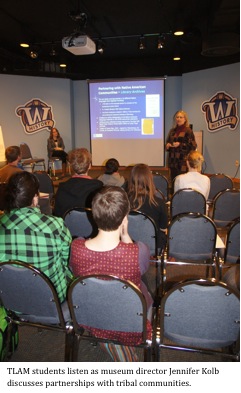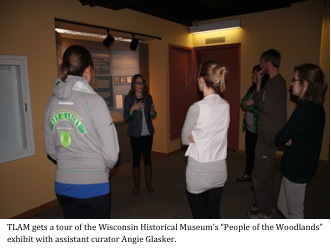Last week, our TLAM class took a field trip to the Wisconsin Historical Museum to visit with the museum’s director, Jennifer Kolb, and assistant curator, Angie Glasker, to discuss the museum’s implementation of NAGPRA (The Native American Graves Protection and Repatriation Act).
 According to Jennifer, NAGPRA has been around for over 25 years and involves the repatriation of culturally sensitive items which include “human remains, funerary objects, sacred objects, and objects of cultural patrimony”. Repatriation through NAGPRA involves a very long and strict process that requires museums to make inventories of these items, consult tribes, and publish their intents in the Federal Register before the items can be repatriated or returned to tribal communities.
According to Jennifer, NAGPRA has been around for over 25 years and involves the repatriation of culturally sensitive items which include “human remains, funerary objects, sacred objects, and objects of cultural patrimony”. Repatriation through NAGPRA involves a very long and strict process that requires museums to make inventories of these items, consult tribes, and publish their intents in the Federal Register before the items can be repatriated or returned to tribal communities.
Jennifer says the consultation is the most important part of the repatriation process. It can be difficult to tell communities that the museum has items that should never have been taken from them in the first place, but it can also be an opportunity to apologize and be honest about the past, build trust and relationships, and learn from one another.
The Wisconsin Historical Museum now has partnerships with many local tribal communities, not only for NAGPRA purposes, but for assistance in other areas as well such as language revitalization and cultural preservation.
Exciting new projects are also in the works. The museum is working on building a State Preservation Archives Facility with special rooms for traditional care, remains and funerary objects, and sacred objects as well as an outside patio. The museum has been working with tribal communities to design the space for specifically for ceremonial use with meaningful architecture representative of tribal culture. A new museum is also being built with the consultation of tribes to include exhibits from a multi-generational native perspective.
The Wisconsin Historical Museum is a great example of how museums can collaborate with tribal communities in order to provide quality exhibits that respect and reflect culture and to assist in keeping American Indian culture and language alive and relevant today.
I look forward to visiting the new museum and learning more about the museum’s future projects with tribal communities!
-Emily Sovell
Related Resources
For more information on NAGPRA, visit their website at http://www.nps.gov/nagpra/
To learn more about the Wisconsin Historical Museum, visit their website at http://historicalmuseum.wisconsinhistory.org/
Ackley, K. (2009). Tsi?niyukwaliho?t, the Oneida Nation Museum: Creating a space for Haudenosaunee kinship and identity. In Sleeper-Smith, S. Contesting knowledge: Museums and indigenous perspectives (pp. 257-282). Lincoln, NE: University of Nebraska Press.
Mithlo, N. M. (2004). “Red man’s burden”: The politics of inclusion in museum settings. The American Indian Quarterly 28(3), 743-763.
Parker, P., & United States. (1990). Keepers of the treasures: Protecting historic properties and cultural traditions on Indian lands: a report on tribal preservation funding needs submitted to Congress by the National Park Service, United States Department of the Interior. Washington, D.C.: The Branch. http://www.cr.nps.gov/crdi/publications/IntroductionandPart1.pdf


